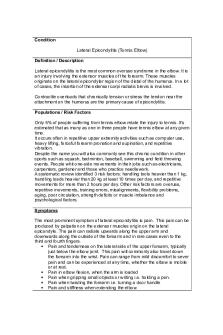Medial meniscus clinical pattern PDF

| Title | Medial meniscus clinical pattern |
|---|---|
| Author | Tsvetina Kupenova |
| Course | Essentials of Musculoskeletal Physiotherapy |
| Institution | University of the West of England |
| Pages | 3 |
| File Size | 94.3 KB |
| File Type | |
| Total Downloads | 3 |
| Total Views | 195 |
Summary
clinical pattern sheet for medial meniscus
info taken from physiopedia and clinical sports medicine...
Description
Condition Medial meniscus injury
Definition / Description The medial meniscus spans the knee medially and is located between the medial tibial and femoral condyles. Tears most often result from weight bearing combined with a rotational force while extending or flexing the knee. A combination of tears is called radial or “parrot beak” which causes the meniscus to split in two directions usually due to a repetitive stress activities such as running. Cartilage degeneration that starts at the inner edge of the meniscus causes a horizontal tear as it works its way back Populations / Risk Factors Prevalence of 12% to 14%. Men from 21 to 30 years old Women from 11 to 19 years old. Degenerative most common in men aged 40 to 60 years old. Often associated with ACL and MCL tears (unhappy triad). Symptoms - (Distribution, description, daily pattern, etc) Popping” sensation when the tear occurs. When inflammation occurs the individual would experience: -pain -swelling -giving away -locking -collection of fluid Fragment of the meniscus may drift into the joint causing a slip, pop or lock which makes the knee stuck at a 45 degree angle until manipulated. Clinical Signs - (Reliable measures) Tenderness over medial joint line. Pain over medial joint line during hyperextension and/or hyperflexion. Pain during external rotation of the foot and the lower leg when the knee is flexed at different angles around 70–90° Weakened or hypotrophied quadriceps muscle. McMurray’s Test The knee is fully flexed and extended whilst internal and external rotation pressure is placed upon it Positive: The patient feels pain and the therapist feels a palpable internal clinking on the joint line.
Apley Test The patient lies prone and flexes the knee of the leg being examined to 90 degrees. Compression - The heel is held and opposes the tibia to the femur, then rotates the tibia externally and internally. An increase in pain, clicking, or locking on compression indicates a torn meniscus. Distraction - The ankle is held and the tibia is pulled upward and away from the femur and then rotated externally and internally.Lessening of pain on distraction indicates a torn meniscus, while increase in pain indicates ligament injury.
History A twisting injury associated with grinding and acute swelling. Pain on posteriomedial aspect of the knee. Pain occurs during rotation, planting and twisting movements. Larger tears cause instability, locking and catching. Degenerative tears become symptomatic after a slip/twist injury or fall followed by swelling developing after 1 day. Investigations - (Radiology, haematoloty etc) MRI scan X-ray arthroscopy
Atypical Presentations ACL MCL Management Options and Levels of Evidence RICE Anti-inflammatory medication Corticosteroid injections Surgery Early mobilisation of knee Strengthening of quadriceps and hamstrings Week 1-2 – Control pain and inflammation, adequate quad/vmo contraction, ROM 090 degrees, PWB ROM 0°-90° ROM exs
Patellar mobs, ankle pumps, Gastroc/soleus stretch, Hamstring/ITB stretch, Prone hangs/heel props STRENGTH Static Qs, SLRs, Hip strengthening Week 2-6 – Same as above, PWB ROM ROM exs 0°- 90˚, Patellar mobs, Gastroc/soleus stretch, Hamstring/ITB stretch, Prone hangs/heel props as needed, Heel/wall slides to reach goal STRENGTH Static Qs, SLR with ankle weights, VMO, Knee extension 90˚ - 30˚ Week 6-12 – Increase lower extremity strength and endurance, increase proprioception and co-ordination, Full ROM, return to play, FWB ROM Full ROM exs, Gastroc/soleus stretch, Hamstring/quad/ITB stretch, Prone hangs/heel props as needed, Patellar mobs if required STRENGTH Exs bike/cross trainer/rower, Wall squats/mini squats, Knee extension (90°-30°), Hamstring Curls, Leg press, Step ups, Heel raises/toe raises, Lunges BALANCE TRAINING Single leg balance, wobble board/cushion, bosu Week 12-36 – Increase neuromuscular control, skill training, sport specific activities, maximal strength and endurance, FWB STRENGTH Continue and progress strengthening (allow full squats) Swimming RUNNING PROGRAMME Enhance neuromuscular control, Progress skill training, Perform controlled sport specific activity and progress to unrestricted sporting activity, Achieve maximal strength, Treadmill running, Progress to outdoor running CUTTING PROGRAMME Lateral shuffle, Figure 8s, Cariocas FUNCTIONAL TRAINING Initiate light plyometrics and progress as able Sport specific drills Useful Resources Equipment and resources that can be utilised in treatment and management...
Similar Free PDFs

Medial meniscus clinical pattern
- 3 Pages

Clinical Pattern sheet
- 10 Pages

COPD - clinical pattern sheets
- 2 Pages

Fascículo longitudinal medial
- 8 Pages

Fascículo longitudinal medial
- 2 Pages

Abdomen lateral medial kaudal
- 8 Pages

Compartimento medial del muslo
- 2 Pages
Popular Institutions
- Tinajero National High School - Annex
- Politeknik Caltex Riau
- Yokohama City University
- SGT University
- University of Al-Qadisiyah
- Divine Word College of Vigan
- Techniek College Rotterdam
- Universidade de Santiago
- Universiti Teknologi MARA Cawangan Johor Kampus Pasir Gudang
- Poltekkes Kemenkes Yogyakarta
- Baguio City National High School
- Colegio san marcos
- preparatoria uno
- Centro de Bachillerato Tecnológico Industrial y de Servicios No. 107
- Dalian Maritime University
- Quang Trung Secondary School
- Colegio Tecnológico en Informática
- Corporación Regional de Educación Superior
- Grupo CEDVA
- Dar Al Uloom University
- Centro de Estudios Preuniversitarios de la Universidad Nacional de Ingeniería
- 上智大学
- Aakash International School, Nuna Majara
- San Felipe Neri Catholic School
- Kang Chiao International School - New Taipei City
- Misamis Occidental National High School
- Institución Educativa Escuela Normal Juan Ladrilleros
- Kolehiyo ng Pantukan
- Batanes State College
- Instituto Continental
- Sekolah Menengah Kejuruan Kesehatan Kaltara (Tarakan)
- Colegio de La Inmaculada Concepcion - Cebu








